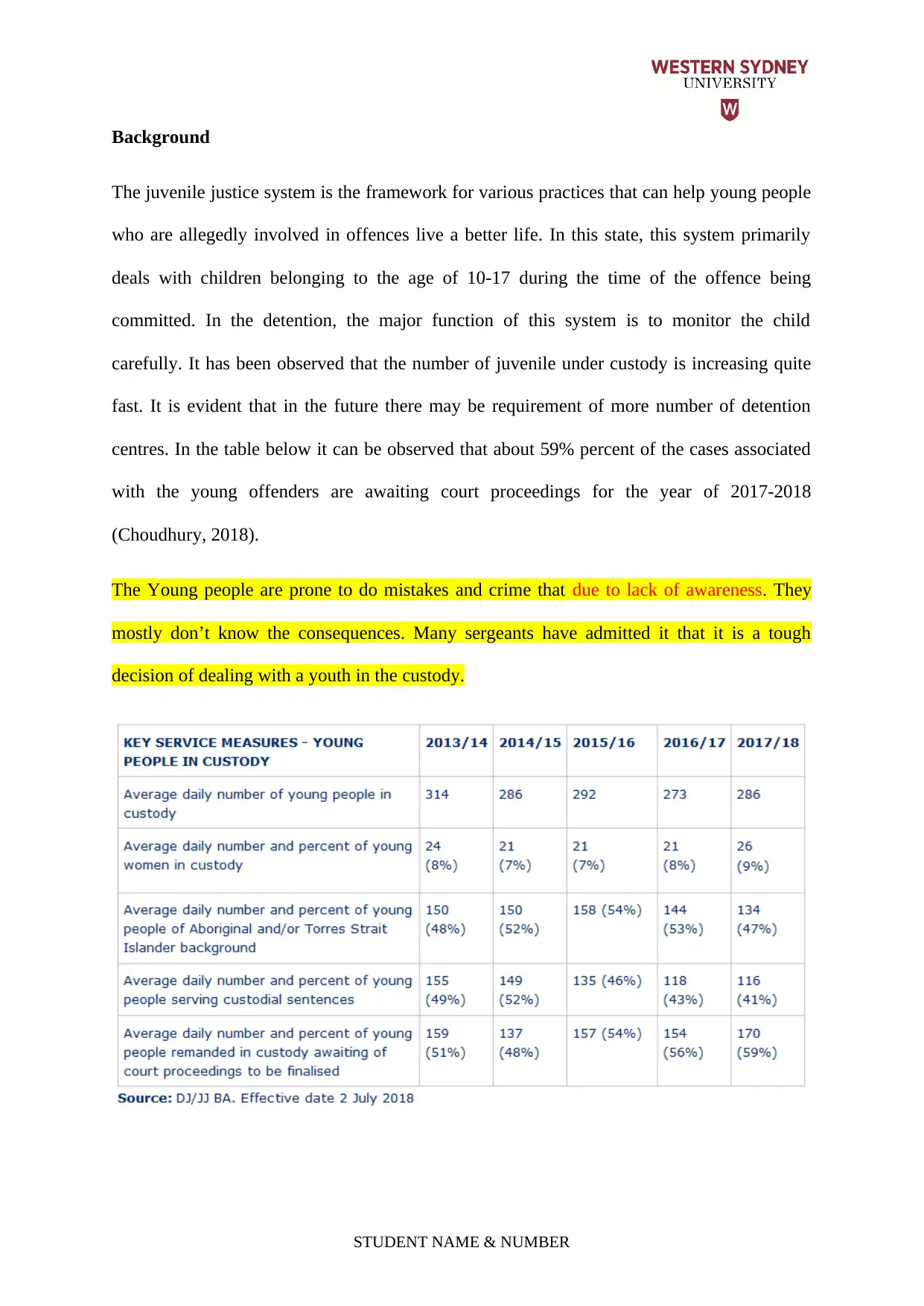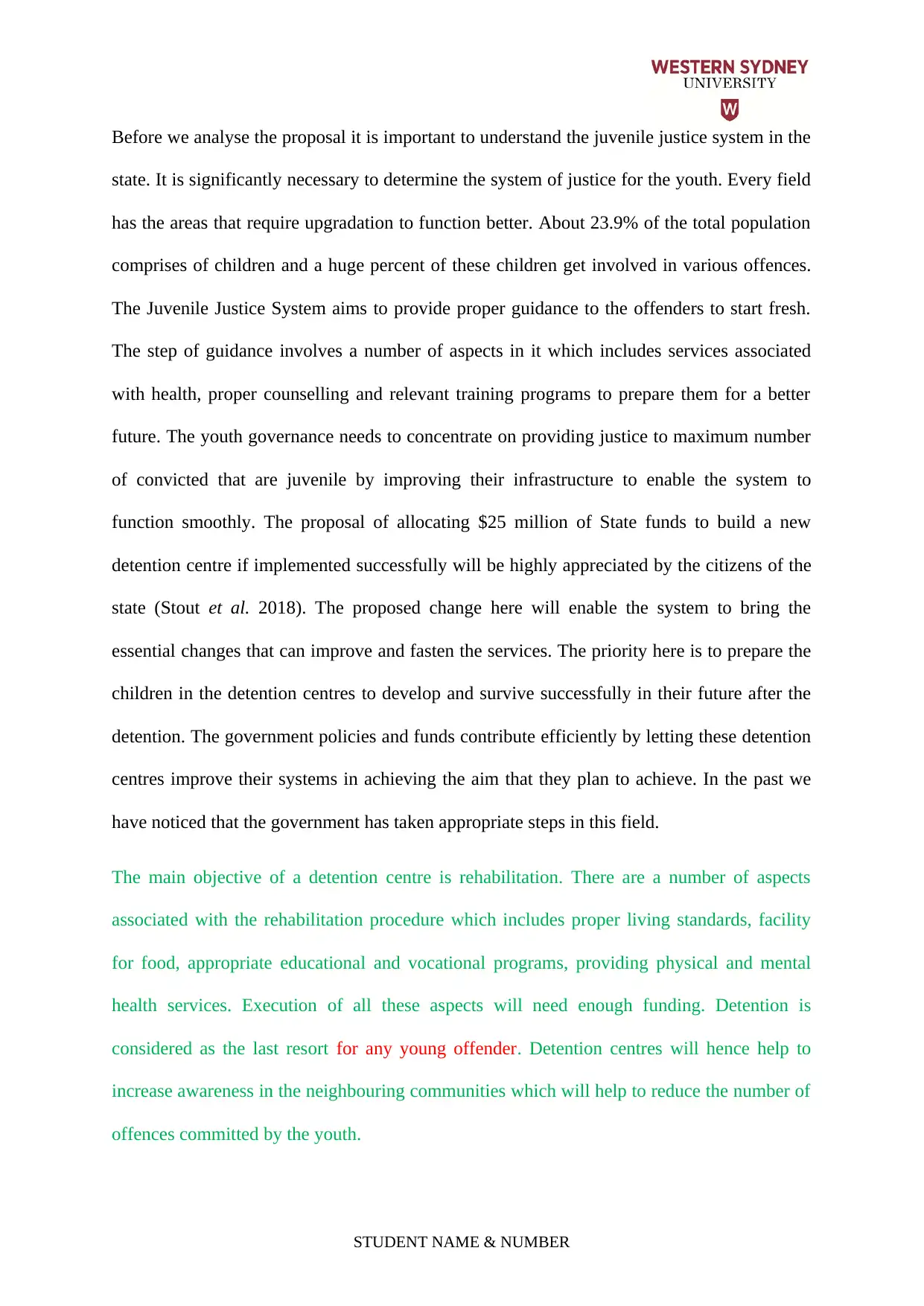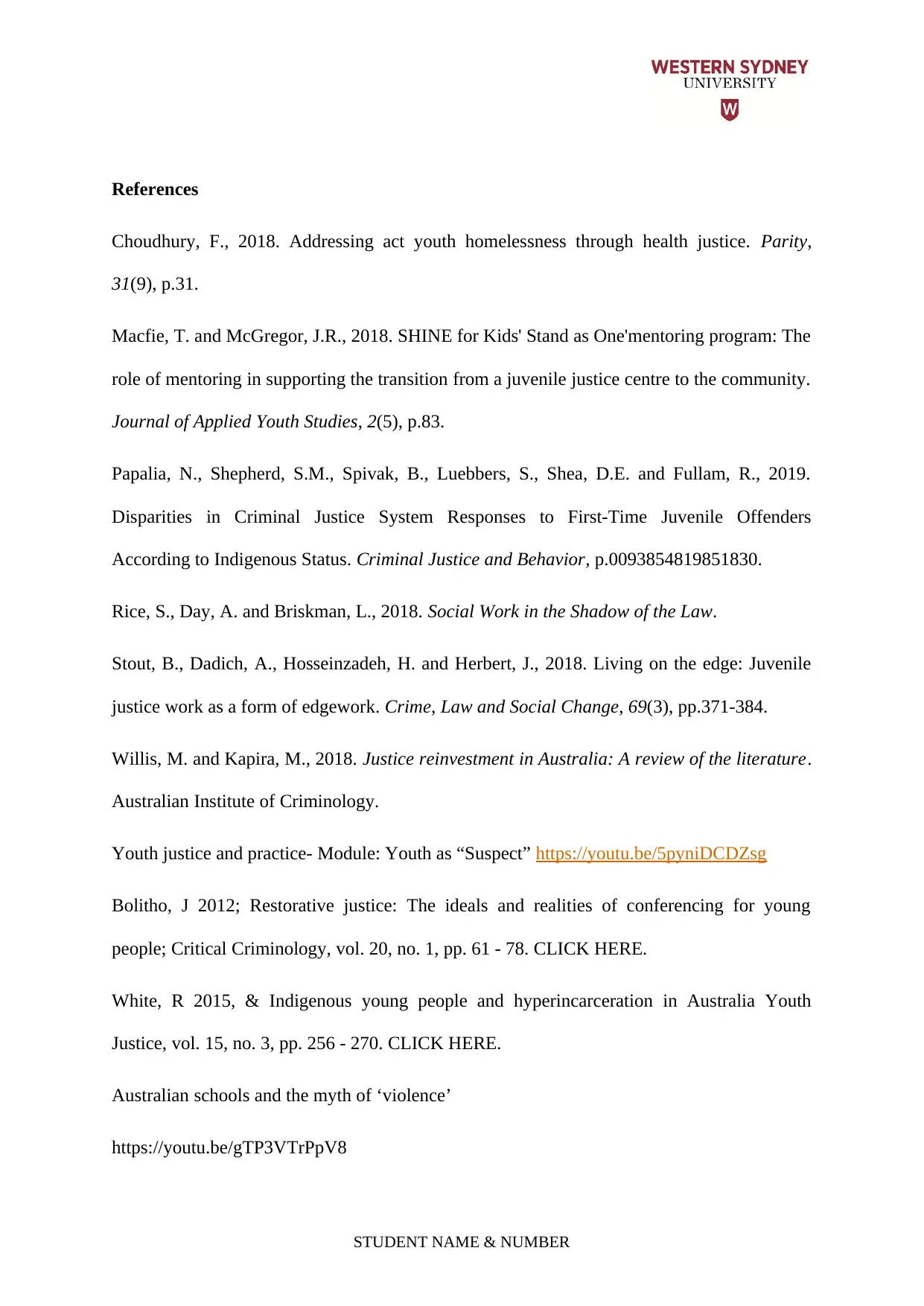Youth Justice in NSW: A Briefing Paper on Detention Centre Proposal
VerifiedAdded on 2023/03/30
|8
|1846
|89
Report
AI Summary
This briefing paper examines the proposal to allocate $25 million of State funds to build a new youth detention centre in NSW from a social worker's perspective. It provides background information on the juvenile justice system, highlighting the increasing number of young offenders and the need for improved infrastructure. The paper analyzes the proposal's potential benefits, such as increased awareness and reduced crime rates, as well as its drawbacks. It also discusses the importance of rehabilitation, proper living standards, and educational programs within detention centres. The analysis considers the Young Offenders Act NSW 1997, and concludes with recommendations for the proposal's implementation, emphasizing the need for careful planning, location selection, and ongoing monitoring to ensure the best outcomes for young people and the community. The paper utilizes scholarly sources and provides a detailed analysis of the proposal's potential consequences.

Assessment 3: Professional Task (Briefing Paper)
Introduction
This assignment concerns with the challenges faced by detention centres in NSW. Juvenile
justice is a major concern for every nation. In this assignment we will discuss about the
proposal that suggests allocating $25 million of State funds to build a new youth detention
centre. Here we will analyse this proposal to come to get a clear idea of this proposal.
Detention can be a difficult phase for a child to experience. In the legal procedure, detention
is considered to be the most extreme mode of contact with a child (Willis et al., 2018). In this
assignment we will first discuss about the proposal and then conduct a detailed research on it
to analyse its effects. Further we will mention a conclusion which will include
recommendations if needed. The entire report will be framed from a social worker’s
perspective. The learning and research in this topic is also done based on the practices and
modules for the governance of youth.
STUDENT NAME & NUMBER
Introduction
This assignment concerns with the challenges faced by detention centres in NSW. Juvenile
justice is a major concern for every nation. In this assignment we will discuss about the
proposal that suggests allocating $25 million of State funds to build a new youth detention
centre. Here we will analyse this proposal to come to get a clear idea of this proposal.
Detention can be a difficult phase for a child to experience. In the legal procedure, detention
is considered to be the most extreme mode of contact with a child (Willis et al., 2018). In this
assignment we will first discuss about the proposal and then conduct a detailed research on it
to analyse its effects. Further we will mention a conclusion which will include
recommendations if needed. The entire report will be framed from a social worker’s
perspective. The learning and research in this topic is also done based on the practices and
modules for the governance of youth.
STUDENT NAME & NUMBER
Paraphrase This Document
Need a fresh take? Get an instant paraphrase of this document with our AI Paraphraser

Background
The juvenile justice system is the framework for various practices that can help young people
who are allegedly involved in offences live a better life. In this state, this system primarily
deals with children belonging to the age of 10-17 during the time of the offence being
committed. In the detention, the major function of this system is to monitor the child
carefully. It has been observed that the number of juvenile under custody is increasing quite
fast. It is evident that in the future there may be requirement of more number of detention
centres. In the table below it can be observed that about 59% percent of the cases associated
with the young offenders are awaiting court proceedings for the year of 2017-2018
(Choudhury, 2018).
The Young people are prone to do mistakes and crime that due to lack of awareness. They
mostly don’t know the consequences. Many sergeants have admitted it that it is a tough
decision of dealing with a youth in the custody.
STUDENT NAME & NUMBER
The juvenile justice system is the framework for various practices that can help young people
who are allegedly involved in offences live a better life. In this state, this system primarily
deals with children belonging to the age of 10-17 during the time of the offence being
committed. In the detention, the major function of this system is to monitor the child
carefully. It has been observed that the number of juvenile under custody is increasing quite
fast. It is evident that in the future there may be requirement of more number of detention
centres. In the table below it can be observed that about 59% percent of the cases associated
with the young offenders are awaiting court proceedings for the year of 2017-2018
(Choudhury, 2018).
The Young people are prone to do mistakes and crime that due to lack of awareness. They
mostly don’t know the consequences. Many sergeants have admitted it that it is a tough
decision of dealing with a youth in the custody.
STUDENT NAME & NUMBER

Before we analyse the proposal it is important to understand the juvenile justice system in the
state. It is significantly necessary to determine the system of justice for the youth. Every field
has the areas that require upgradation to function better. About 23.9% of the total population
comprises of children and a huge percent of these children get involved in various offences.
The Juvenile Justice System aims to provide proper guidance to the offenders to start fresh.
The step of guidance involves a number of aspects in it which includes services associated
with health, proper counselling and relevant training programs to prepare them for a better
future. The youth governance needs to concentrate on providing justice to maximum number
of convicted that are juvenile by improving their infrastructure to enable the system to
function smoothly. The proposal of allocating $25 million of State funds to build a new
detention centre if implemented successfully will be highly appreciated by the citizens of the
state (Stout et al. 2018). The proposed change here will enable the system to bring the
essential changes that can improve and fasten the services. The priority here is to prepare the
children in the detention centres to develop and survive successfully in their future after the
detention. The government policies and funds contribute efficiently by letting these detention
centres improve their systems in achieving the aim that they plan to achieve. In the past we
have noticed that the government has taken appropriate steps in this field.
The main objective of a detention centre is rehabilitation. There are a number of aspects
associated with the rehabilitation procedure which includes proper living standards, facility
for food, appropriate educational and vocational programs, providing physical and mental
health services. Execution of all these aspects will need enough funding. Detention is
considered as the last resort for any young offender. Detention centres will hence help to
increase awareness in the neighbouring communities which will help to reduce the number of
offences committed by the youth.
STUDENT NAME & NUMBER
state. It is significantly necessary to determine the system of justice for the youth. Every field
has the areas that require upgradation to function better. About 23.9% of the total population
comprises of children and a huge percent of these children get involved in various offences.
The Juvenile Justice System aims to provide proper guidance to the offenders to start fresh.
The step of guidance involves a number of aspects in it which includes services associated
with health, proper counselling and relevant training programs to prepare them for a better
future. The youth governance needs to concentrate on providing justice to maximum number
of convicted that are juvenile by improving their infrastructure to enable the system to
function smoothly. The proposal of allocating $25 million of State funds to build a new
detention centre if implemented successfully will be highly appreciated by the citizens of the
state (Stout et al. 2018). The proposed change here will enable the system to bring the
essential changes that can improve and fasten the services. The priority here is to prepare the
children in the detention centres to develop and survive successfully in their future after the
detention. The government policies and funds contribute efficiently by letting these detention
centres improve their systems in achieving the aim that they plan to achieve. In the past we
have noticed that the government has taken appropriate steps in this field.
The main objective of a detention centre is rehabilitation. There are a number of aspects
associated with the rehabilitation procedure which includes proper living standards, facility
for food, appropriate educational and vocational programs, providing physical and mental
health services. Execution of all these aspects will need enough funding. Detention is
considered as the last resort for any young offender. Detention centres will hence help to
increase awareness in the neighbouring communities which will help to reduce the number of
offences committed by the youth.
STUDENT NAME & NUMBER
⊘ This is a preview!⊘
Do you want full access?
Subscribe today to unlock all pages.

Trusted by 1+ million students worldwide

Research and analysis of the proposal
In this part of the assessment we aim to research and analyse the proposal by discussing both
the positive and the negative aspects associated with the proposal. In every individual’s life
the young age plays an important role as it helps to develop as a human being. Hence, the
juvenile justice system can effectively contribute in providing the convicted ones with an
opportunity to survive as a normal human being. Children commit crime in various situations,
and these detention centres try to identify those factors and work on it extensively in order to
prevent the person from committing a crime in the future. The society on the other hand does
not take it in a positive way, and hence, it has been observed that in many cases the life after
detention was quite challenging. Hence, every nation has their system for juvenile justice
(Macfie, 2018).
Building a new detention centre will benefit a number of people. A detention centre in an
area will help to increase awareness in the surrounding societies which will eventually help to
reduce the crime rates in that area. The police, as well as, the legal aid will be benefitted as
the pending cases can be executed successfully, which can be proved by the module of youth
justice and practices where various responses are obtained in support of the youth. The youth
generation should get proper justice for every juvenile act they do. However the
consequences should have been very tough for them. This is confirmed by Denise Lynch and
Margarette Webb who are sergeants and are dealing with youth based cases. Adolescent
psychologists will get the opportunity to provide service in these newly built detention
centres. The educational institutions will be provided with services that will help in creating
awareness. Overall it will be beneficial in every aspect. Hence, I totally support this proposal.
STUDENT NAME & NUMBER
In this part of the assessment we aim to research and analyse the proposal by discussing both
the positive and the negative aspects associated with the proposal. In every individual’s life
the young age plays an important role as it helps to develop as a human being. Hence, the
juvenile justice system can effectively contribute in providing the convicted ones with an
opportunity to survive as a normal human being. Children commit crime in various situations,
and these detention centres try to identify those factors and work on it extensively in order to
prevent the person from committing a crime in the future. The society on the other hand does
not take it in a positive way, and hence, it has been observed that in many cases the life after
detention was quite challenging. Hence, every nation has their system for juvenile justice
(Macfie, 2018).
Building a new detention centre will benefit a number of people. A detention centre in an
area will help to increase awareness in the surrounding societies which will eventually help to
reduce the crime rates in that area. The police, as well as, the legal aid will be benefitted as
the pending cases can be executed successfully, which can be proved by the module of youth
justice and practices where various responses are obtained in support of the youth. The youth
generation should get proper justice for every juvenile act they do. However the
consequences should have been very tough for them. This is confirmed by Denise Lynch and
Margarette Webb who are sergeants and are dealing with youth based cases. Adolescent
psychologists will get the opportunity to provide service in these newly built detention
centres. The educational institutions will be provided with services that will help in creating
awareness. Overall it will be beneficial in every aspect. Hence, I totally support this proposal.
STUDENT NAME & NUMBER
Paraphrase This Document
Need a fresh take? Get an instant paraphrase of this document with our AI Paraphraser

Young people usually tend to get involved in various crimes. Hence, the government should
take necessary steps to prevent the involvement of children in any kind of criminal offence.
Children are young and do not have the capability to determine what is good and what is bad.
The family and society influences their upbringing however, it does not take much time to get
influenced by the wrong section of the society (Papalia et al, 2019). A new detention centre
will further cover more area and spread awareness by conducting relevant awareness camps
and seminars in the nearby schools and housing communities. These awareness camps will
hence provide children with a varied of information about what is crime and other details
about unlawful activities. This will hence have a positive impact on the society. The youth
belonging to the minority groups will be benefitted on the approval of this proposal.
A child is being influenced to a great extent by their families. Hence, the parliament of NSW
approved the proposal of active involvement of parents in the detention procedure. The main
aim of this proposal was to provide support to families who face issues while raising their
children and to encourage parents to monitor their children so that they do not get involved in
any criminal activities. These approaches had a positive impact in both the convicted ones
and their families. The juvenile system was benefitted as it was easier to train children who
were offenders. On the other hand by providing support to parents facing issues in raising
their children they successfully prevented the occurrence of juvenile crime in the state (Rice,
2018).
On the basis of researches that were done in the past it has been observed that
the existing detention centres are in miserable conditions in terms of upgrading
their procedures. If the main objective of providing support to the children is not
fulfilled then there is no point running them at the first place. With
technological advancement there are various ways to improve their services.
And this fund can be utilised to do so.
STUDENT NAME & NUMBER
take necessary steps to prevent the involvement of children in any kind of criminal offence.
Children are young and do not have the capability to determine what is good and what is bad.
The family and society influences their upbringing however, it does not take much time to get
influenced by the wrong section of the society (Papalia et al, 2019). A new detention centre
will further cover more area and spread awareness by conducting relevant awareness camps
and seminars in the nearby schools and housing communities. These awareness camps will
hence provide children with a varied of information about what is crime and other details
about unlawful activities. This will hence have a positive impact on the society. The youth
belonging to the minority groups will be benefitted on the approval of this proposal.
A child is being influenced to a great extent by their families. Hence, the parliament of NSW
approved the proposal of active involvement of parents in the detention procedure. The main
aim of this proposal was to provide support to families who face issues while raising their
children and to encourage parents to monitor their children so that they do not get involved in
any criminal activities. These approaches had a positive impact in both the convicted ones
and their families. The juvenile system was benefitted as it was easier to train children who
were offenders. On the other hand by providing support to parents facing issues in raising
their children they successfully prevented the occurrence of juvenile crime in the state (Rice,
2018).
On the basis of researches that were done in the past it has been observed that
the existing detention centres are in miserable conditions in terms of upgrading
their procedures. If the main objective of providing support to the children is not
fulfilled then there is no point running them at the first place. With
technological advancement there are various ways to improve their services.
And this fund can be utilised to do so.
STUDENT NAME & NUMBER

According to our analysis it is quite evident that on approving this proposal the state will be
benefited in various aspects. Juvenile justice system needs to be monitored in order to
identify the areas that require improvement. In order to upgrade their system they will need
relevant funds and hence this investment can be utilised significantly. This is done in the light
of Young Offenders Act NSW 1997 which talks about the juvenile justice system.
Recommendation and conclusion
Children are considered to be the future of a nation, hence the government of every state
should take necessary steps to ensure that children are provided with every facility to develop
in every aspect. On approval of the proposal of allocating $25 million of State funds to build
a new youth detention centre needs a number of other steps involve in it. The first step after
approval involves planning, primarily it is important to identify the area that has a high record
of juvenile crime and approving the idea of building it here. Once the location is finalised the
set up involves effective implementation of the plan. Once the detention centre is set up it is
important to monitor their systems carefully. Regular monitoring and taking help from new
researches will help them upgrade their infrastructure. Spending millions of dollars of State
Funds on a new detention centre is an appropriate initiative to address juvenile offending. As
mentioned in the analysis section we can observe every section of the society that deals with
children will be benefitted with the formation of a detention centre.
STUDENT NAME & NUMBER
benefited in various aspects. Juvenile justice system needs to be monitored in order to
identify the areas that require improvement. In order to upgrade their system they will need
relevant funds and hence this investment can be utilised significantly. This is done in the light
of Young Offenders Act NSW 1997 which talks about the juvenile justice system.
Recommendation and conclusion
Children are considered to be the future of a nation, hence the government of every state
should take necessary steps to ensure that children are provided with every facility to develop
in every aspect. On approval of the proposal of allocating $25 million of State funds to build
a new youth detention centre needs a number of other steps involve in it. The first step after
approval involves planning, primarily it is important to identify the area that has a high record
of juvenile crime and approving the idea of building it here. Once the location is finalised the
set up involves effective implementation of the plan. Once the detention centre is set up it is
important to monitor their systems carefully. Regular monitoring and taking help from new
researches will help them upgrade their infrastructure. Spending millions of dollars of State
Funds on a new detention centre is an appropriate initiative to address juvenile offending. As
mentioned in the analysis section we can observe every section of the society that deals with
children will be benefitted with the formation of a detention centre.
STUDENT NAME & NUMBER
⊘ This is a preview!⊘
Do you want full access?
Subscribe today to unlock all pages.

Trusted by 1+ million students worldwide

References
Choudhury, F., 2018. Addressing act youth homelessness through health justice. Parity,
31(9), p.31.
Macfie, T. and McGregor, J.R., 2018. SHINE for Kids' Stand as One'mentoring program: The
role of mentoring in supporting the transition from a juvenile justice centre to the community.
Journal of Applied Youth Studies, 2(5), p.83.
Papalia, N., Shepherd, S.M., Spivak, B., Luebbers, S., Shea, D.E. and Fullam, R., 2019.
Disparities in Criminal Justice System Responses to First-Time Juvenile Offenders
According to Indigenous Status. Criminal Justice and Behavior, p.0093854819851830.
Rice, S., Day, A. and Briskman, L., 2018. Social Work in the Shadow of the Law.
Stout, B., Dadich, A., Hosseinzadeh, H. and Herbert, J., 2018. Living on the edge: Juvenile
justice work as a form of edgework. Crime, Law and Social Change, 69(3), pp.371-384.
Willis, M. and Kapira, M., 2018. Justice reinvestment in Australia: A review of the literature.
Australian Institute of Criminology.
Youth justice and practice- Module: Youth as “Suspect” https://youtu.be/5pyniDCDZsg
Bolitho, J 2012; Restorative justice: The ideals and realities of conferencing for young
people; Critical Criminology, vol. 20, no. 1, pp. 61 - 78. CLICK HERE.
White, R 2015, & Indigenous young people and hyperincarceration in Australia Youth
Justice, vol. 15, no. 3, pp. 256 - 270. CLICK HERE.
Australian schools and the myth of ‘violence’
https://youtu.be/gTP3VTrPpV8
STUDENT NAME & NUMBER
Choudhury, F., 2018. Addressing act youth homelessness through health justice. Parity,
31(9), p.31.
Macfie, T. and McGregor, J.R., 2018. SHINE for Kids' Stand as One'mentoring program: The
role of mentoring in supporting the transition from a juvenile justice centre to the community.
Journal of Applied Youth Studies, 2(5), p.83.
Papalia, N., Shepherd, S.M., Spivak, B., Luebbers, S., Shea, D.E. and Fullam, R., 2019.
Disparities in Criminal Justice System Responses to First-Time Juvenile Offenders
According to Indigenous Status. Criminal Justice and Behavior, p.0093854819851830.
Rice, S., Day, A. and Briskman, L., 2018. Social Work in the Shadow of the Law.
Stout, B., Dadich, A., Hosseinzadeh, H. and Herbert, J., 2018. Living on the edge: Juvenile
justice work as a form of edgework. Crime, Law and Social Change, 69(3), pp.371-384.
Willis, M. and Kapira, M., 2018. Justice reinvestment in Australia: A review of the literature.
Australian Institute of Criminology.
Youth justice and practice- Module: Youth as “Suspect” https://youtu.be/5pyniDCDZsg
Bolitho, J 2012; Restorative justice: The ideals and realities of conferencing for young
people; Critical Criminology, vol. 20, no. 1, pp. 61 - 78. CLICK HERE.
White, R 2015, & Indigenous young people and hyperincarceration in Australia Youth
Justice, vol. 15, no. 3, pp. 256 - 270. CLICK HERE.
Australian schools and the myth of ‘violence’
https://youtu.be/gTP3VTrPpV8
STUDENT NAME & NUMBER
Paraphrase This Document
Need a fresh take? Get an instant paraphrase of this document with our AI Paraphraser

Denise Lynch
https://youtu.be/u0pdRWeY_5E
Margaret Webb
https://youtu.be/irhmAqRAPmw
Margaret Webb
STUDENT NAME & NUMBER
https://youtu.be/u0pdRWeY_5E
Margaret Webb
https://youtu.be/irhmAqRAPmw
Margaret Webb
STUDENT NAME & NUMBER
1 out of 8
Related Documents
Your All-in-One AI-Powered Toolkit for Academic Success.
+13062052269
info@desklib.com
Available 24*7 on WhatsApp / Email
![[object Object]](/_next/static/media/star-bottom.7253800d.svg)
Unlock your academic potential
Copyright © 2020–2025 A2Z Services. All Rights Reserved. Developed and managed by ZUCOL.





